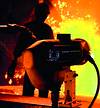

In many industries monitoring temperature is a critical part of the manufacturing process.
For manufacturers who rely on temperature measurement to control product quality, non-contact infrared thermometers have become invaluable tools. A market leader in infrared temperature measurement, especially 2-colour technology, is Raytek with its Marathon Series.
Unlike standard (one-colour) thermometers, the accuracy of ratio (two-colour) instruments does not depend on the target filling the field-of-view of the instrument. In addition, ratio thermometers are more accurate than standard instruments in applications where there is dust, steam, or particles in the atmosphere, where the field-of-view of the instrument is partially obscured, or where the emissivity of the target varies.
In standard (one-colour) infrared thermometry, the instrument captures some of the infrared (IR) energy that is emitted by an object. The amount of energy emitted by an object is the product of a physical parameter of the object, called emissivity, times the energy emitted by an ideal radiator, or blackbody, at the same temperature.
In contrast to standard (one-colour) IR thermometers, ratio (two-colour) instruments pass the captured IR energy through two IR filters that limit the IR radiation to two different wavelength bands. The IR radiation for each filter is then directed to two separate IR detectors where it is converted to an electrical signal. The microprocessor of the instrument calculates a ratio by dividing the signal from one detector by the signal from the second detector. This ratio is now proportional to the object temperature.
If the target does not fill the field-of-view of the ratio instrument, the amount of energy that reaches each of the two detectors is also dependent on the distance between the object and the instrument. However, the change in the amount of energy that reaches the instrument is the same for each detector. This means that the ratio of the energy remains the same. Therefore it is not necessary that the target fill the field-of-view of a ratio instrument in order to ensure accurate temperature measurement. This is also true when the target is obscured or when the amount of energy that reaches the instrument is attenuated because of atmospheric conditions, provided the attenuation is the same in both wavelength bands.
Ratio thermometers will tolerate up to a 95% reduction of energy due to obscuration or attenuation and still remain accurate. So if 5% of the object is able to be seen (due to dust or smoke) an accurate reading may still be taken. A standard instrument measuring the same object with the same percent of energy attenuation will have a 30% error in the temperature reading.
Because ratio thermometers are less affected by obscuration and energy attenuation than standard instruments, they are suitable for use in many applications where a standard instrument cannot provide an accurate temperature measurement. The following are the most common conditions where a ratio thermometer is the best solution:
* Energy reaching the instrument is reduced because of dust, smoke, steam, or particles in the atmosphere.
* The sighting window or lens is dirty.
* The instrument's field-of-view is partially blocked or obscured.
* The target does not fill the instrument's field-of-view.
* The target is smaller than the instrument's field-of-view and is moving or vibrating.
* Changes in emissivity on object due to slag or scale.
Most ratio thermometers are designed for use in high temperature applications. A typical temperature range for a ratio instrument is 600 to 3000°C. Optical resolution does vary, with some instruments having an optical resolution of up to 130 to 1. Response time, which is the length of time it takes the instrument to respond to a change in the target's temperature, is as brief as 10 ms.
The Raytek 2-colour Marathon Series has the ability to switch between single and 2-colour allowing the user to select the right parameter for an application. Accessories that protect the thermometer from harsh environments are also available. A rugged, metal jacket allows the instrument to be used in areas where the ambient temperature can reach up to 315°C. This protective jacket completely encloses the instrument and has air and water-cooling built in.
| Tel: | +27 11 608 1551 |
| Email: | [email protected] |
| www: | www.randci.co.za |
| Articles: | More information and articles about R&C Instrumentation |

© Technews Publishing (Pty) Ltd | All Rights Reserved